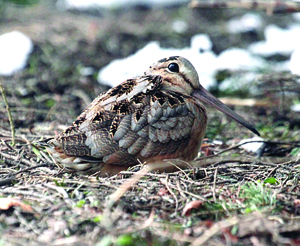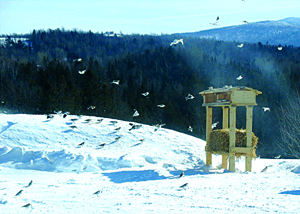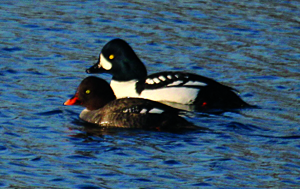

by Martha Steele
Seasons in Orleans County are not just about changing weather, leaves, or recreational pursuits. They also bring wide swings in bird populations, from the near absence of sound or flight during a mid-winter walk in the woods to the deafening chorus of an early spring morning.
My husband, Bob Stymeist, and I have been regularly visiting my mother in Westmore and chronicling the birds we see and hear all year-round. In 2013, over 56 days, we tallied a total of 152 bird species in Orleans County for the year, our personal record. In all, birders recorded 179 species in Orleans County in 2013, according to Cornell Laboratory of Ornithology’s eBird. Our total number since we started birding the county about a decade ago is 178 species.
Birders love statistics and to keep lists. A yard list. A town list. A county list. A year list. A trip list. A life list. The term “lifer” becomes a unique word for birders, not only indicating a new species that the birder has never seen, but expanding to anything new to the individual, be it a road, a restaurant, or anything at all.
For us, Orleans County holds special affection. It is where we welcome back our avian friends every spring. “Our” wood thrush returns every year to a particular spot on our property. A northern waterthrush greets us with song every spring morning along the road to Willoughby. A chestnut-sided warbler sets up territory near our mailbox. We are truly astonished and moved by the ability of birds to travel thousands of miles to and from their wintering or breeding grounds, only to settle in the same place as the year before. Welcome back indeed.

Our year starts in January, with four Common Loons on Lake Willoughby being the first birds of 2013. We are lucky to record 20 or 30 species by late February, mostly of the chickadee, nuthatch, blue jay, or other feeder bird variety. As the days get longer and temperatures begin to thaw on lakes and ponds, we may be lucky enough to get a raft of ducks showing up in March as they begin their migrations north to their Arctic breeding grounds.
In 2013, we happened to be in Newport in late March when a small area of Lake Memphremagog (we affectionately call it Lake Make-Me-An-Eggnog) near the municipal parking lot in downtown Newport opened up and was filled with 15 different species of waterfowl, including a pair of rare Barrow’s goldeneyes.
Then come the American woodcock. Among the earliest migrants to return, the woodcock are known for their spectacular aerial mating displays, where they spiral high into the air, and then dive back to earth to try to impress a possible mate. Once on the ground, they call an unmistakably loud nasal call: “peent,” a sound that literally brings Bob and me out of our seats, arms raised with excitement: “They are back!” We drive slowly in the fading evening light counting woodcocks, sometimes still on snow-covered fields. It is truly a wonderful sign of the coming spring.
As the spring moves along, more and more migrants arrive or pass through. Swallows and bluebirds start looking for nesting boxes and cruising the fields. More and more song fills the air, and more and more excitement motivates us to rise with the sun and go listen and look for the returning travelers. Warblers, wrens, thrushes, vireos, tanagers, grosbeaks, and others start to show up. The months of May and June are particularly active, both with migrants and birds setting up territories and displaying to attract mates and start their broods.

By June, most birds that will return have done so, and we plan our annual Big Day. This is a blitz of Orleans County where we try to find as many bird species in one 24-hour period as possible. Our goal is always to find 100 species. In 2013, we succeeded, by finding 103 species on June 13. Our final species of the day were a peregrine falcon at Jobs Pond, a bald eagle at the Clyde River, an American bittern flying across the road close to home, and an American woodcock in the fields below us as night fell.
Midsummer is a quiet time, with little song as parents are tending to their young. We know the birds are all around us, but we seldom hear or even see them. Then, as fall starts to approach, the reverse migration back south begins.
One group of birds that is difficult to find in the Kingdom are shorebirds. We look for appropriate habitat (usually small puddles in which the birds can wade and feed) but lack of rainfall leaves many places dry and empty of shorebirds. We also look for mixed flocks of fall warblers (often much more drab colored than with their spring plumage) and other songbirds, hoping to add to our annual species total. Waterfowl and sparrows generally come a little later in the fall, passing through to their wintering grounds. But as the fall fades into early winter, birds get harder and harder to find, and adding another species or two to our year list gets increasingly difficult. Our final birds of 2013 were Lapland longspur and white-winged scoter.
Birding takes patience. You may go a while before seeing a bird when out in January or February. But it is hard not to marvel at their ability to survive and even thrive in this harsh climate (for the residents) and across the hemispheres (for the migrants). Seeing a whirling flock of snow buntings in winter swooping here and there, or a single scarlet tanager in all its red and black glory helps me, at least, feel grounded in some way. These birds are our birds. We welcome them back every year, we see them in the same places every year, we wish them well on their journey back south every year, and we begin the new year with them every year.

No matter how cold, wet, warm, or windy it may be, we can always go birding somewhere and try to find something. That is the beauty of birding. It gets us out, has us exploring every nook and cranny of Orleans County, or wherever we are, and it brings constant excitement. In 2013, we added ten bird species to our Orleans County list, all species that we had never seen before in the county, such as the olive-sided flycatcher outside our kitchen window, the red crossbills on our driveway, and the Bonaparte’s gull on Lake Memphremagog.
Now, we start a new year. We couldn’t wait to get up on January 1, 2014, despite the cold, and to start a New Year list for Orleans County. One of our first birds of the year was a rough-legged hawk in Craftsbury, the first time we have ever seen this species in Orleans County. We are off to a great start! So, the next time you take a walk, be aware of the bird life around you. Listen to their songs and wish them well. They are your birds, too.
For more free articles from the Chronicle like this one, see our Featuring pages. For all the Chronicle’s stories, pick up a print copy or subscribe, either for print or digital editions.







